 Newer Theories
Newer Theories
You have surely noticed that the seminal grand theorists (Freud, Erikson, Pavlov, Skinner, Piaget) were all men, scientists from western Europe or North America, born more than a hundred years ago. These background variables are limiting. (Of course, female, non—
New theories have emerged that, unlike the grand theories, are multicultural and multidisciplinary and thus are more in accord with the life-
Sociocultural Theory: Vygotsky and Beyond
sociocultural theory A newer theory that holds that development results from the dynamic interaction of each person with the surrounding social and cultural forces.
The central thesis of sociocultural theory is that human development results from the dynamic interaction between developing persons and their surrounding society. Culture is viewed not as something external that impinges on developing persons but as integral to their development every day via the social context (all the dynamic systems described in Chapter 1).
Social Interaction
The pioneer of the sociocultural perspective was Lev Vygotsky (1896–
apprenticeship in thinking Vygotsky’s term for how cognition is stimulated and developed in people by more skilled members of society.
Vygotsky was a leader in describing the interaction between culture and education. He noted that each community in his native Russia (comprising Asians and Europeans, of many faiths and many languages) taught children whatever beliefs and habits were valued in each culture. He studied cognitive competency in many people, including children with special needs. For example, his research included how farmers used tools, how illiterate people thought of abstract ideas, and how children learned in school. In his view, each person, schooled or not, develops with the guidance of more skilled members of his or her society, who are tutors or mentors in an apprenticeship in thinking (Vygotsky, 1934/1986).
guided participation The process by which people learn from others who guide their experiences and explorations.
To describe this process, Vygotsky developed the concept of guided participation, the method used by parents, teachers, and entire societies to teach novices the skills and habits expected within their culture. Tutors engage learners (also called apprentices) in joint activities, offering not only instruction but also “mutual involvement in several widespread cultural practices with great importance for learning: narratives, routines, and play” (Rogoff, 2003, p. 285). Active apprenticeship is a central concept of sociocultural theory because each person depends on others to learn. This process of guided participation is informal, pervasive, and social.
For example, one of my students came to my office with her young son, who eyed my candy dish but did not take any.
“He can have one if it’s all right with you,” I whispered to his mother.
She nodded and told him, “Dr. Berger will let you have one piece of candy.”
He smiled shyly and quickly took one.
“What do you say?” she prompted.
“Thank you,” he replied, glancing at me out of the corner of his eye.
“You’re welcome,” I said.
In that brief moment, all three of us were engaged in cultural transmission. We were surrounded by cultural traditions and practices, including my authority as professor and the fact that I have an office and a candy dish (a social custom that I learned from one of my teachers). True to my culture, I deferred to the direct authority of the mother, who, true to her culture, had taught her son to be polite and obedient. As an apprentice, he needed to be reminded to say “thank you.” I guided him as well, in part by saying he could have one piece (encouraging math, authority, and moderation all at once). Specifics differ, but all adults teach children skills expected in their society and culture.
All cultural patterns and beliefs are social constructions, not natural laws, according to sociocultural theorists. These theorists find customs to be powerful, shaping the development of every person, and they also find that some assumptions need to shift to allow healthier development. Vygotsky stressed this point, arguing that mentally and physically disabled children should be educated (Vygotsky, 1925/1994). This is a cultural belief that has become law in the United States but is not yet accepted in many other nations.
The Zone of Proximal Development
According to sociocultural theory, all learning is social, whether people are learning a manual skill, a social custom, or a language. As part of the apprenticeship of thinking, a mentor (parent, peer, or professional) finds the learner’s zone of proximal development, which contains the skills, knowledge, and concepts that the learner is close (proximal) to acquiring but cannot yet master without help.
Through sensitive assessment of the learner, the mentor engages the mentee within that zone. Together, in a “process of joint construction,” new knowledge is attained (Valsiner, 2006). The mentor must avoid two opposite dangers: boredom and failure. Some frustration is permitted, but the learner must be actively engaged, never passive or overwhelmed (see Figure 2.2).
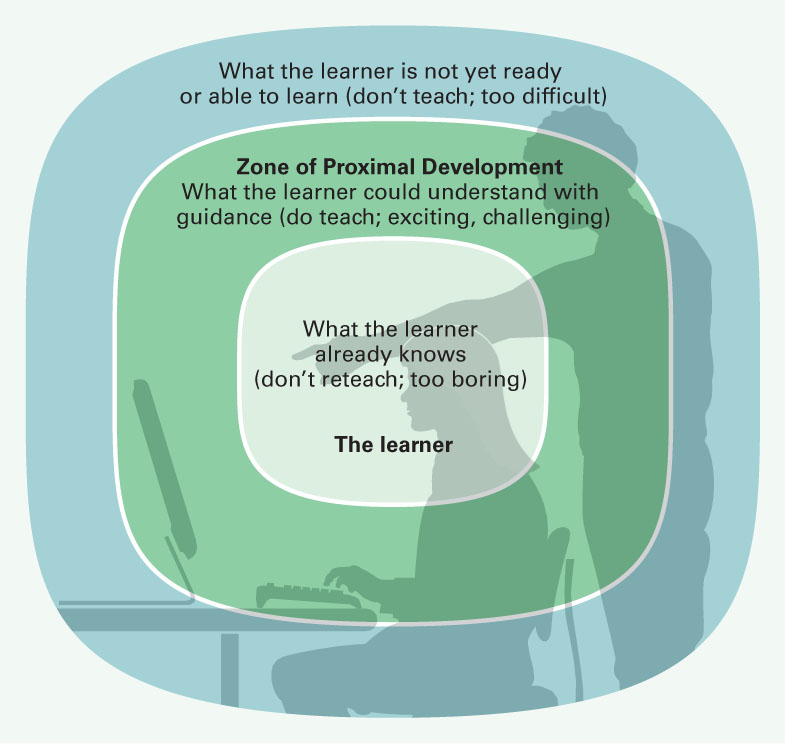
FIGURE 2.2
The Magic Middle Somewhere between the boring and the impossible is the zone of proximal development, where interaction between teacher and learner results in knowledge never before grasped or skills not already mastered. The intellectual excitement of that zone is the origin of the joy that both instruction and study can bring.To make this seemingly abstract process more concrete, consider an example: a father teaching his daughter to ride a bicycle. He begins by rolling her along, supporting her weight while telling her to keep her hands on the handlebars, to push the right and left pedals in rhythm, and to look straight ahead. As she becomes more comfortable and confident, he begins to roll her along more quickly, praising her for steadily pumping. Within a few lessons, he is jogging beside her, holding only the handlebars. When he senses that she could maintain her balance, he urges her to pedal faster while he loosens his grip. Perhaps without realizing it, she rides on her own.
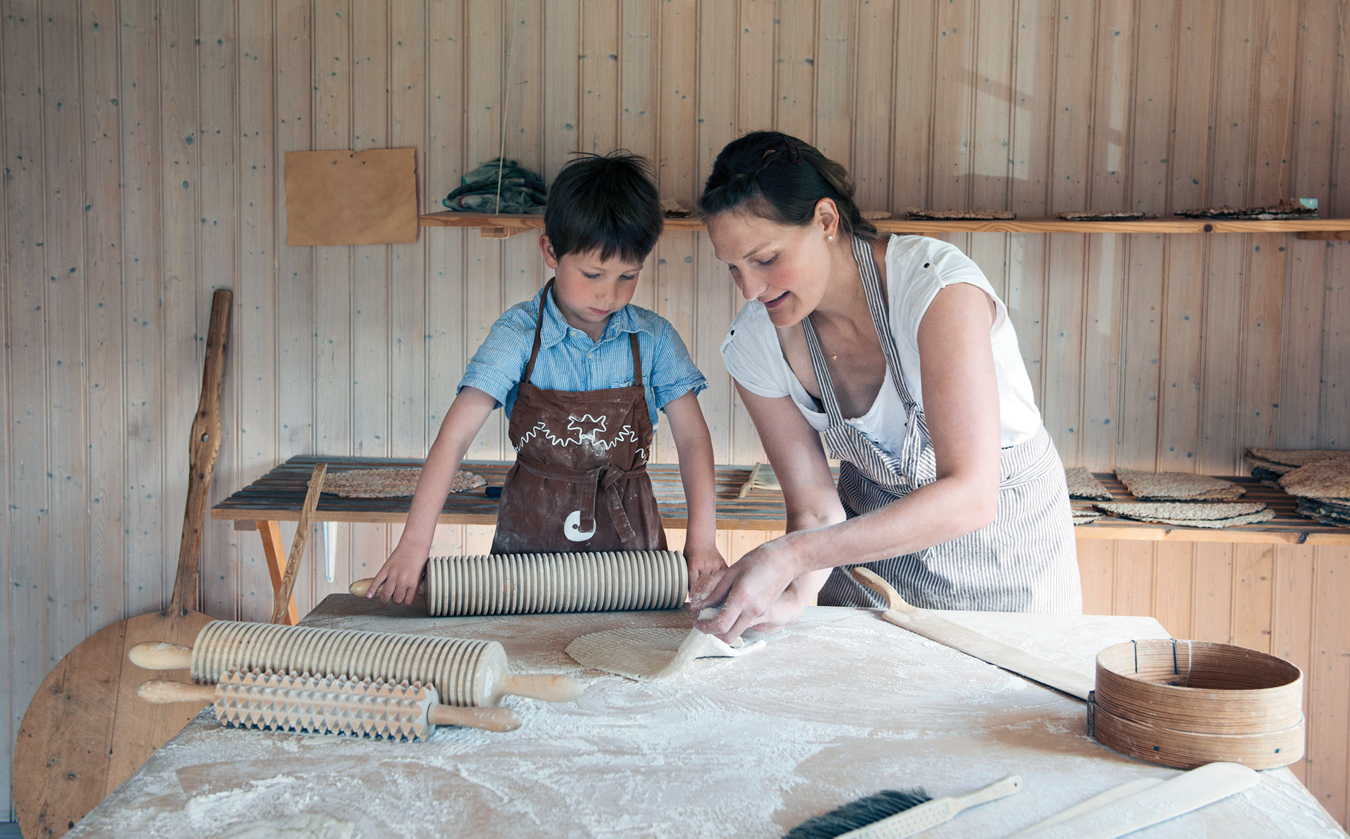
Note that this is not instruction by preset rules or reinforcement. Sociocultural learning is active: No one learns bike-
Excursions into and through the zone of proximal development, as illustrated by the boy prompted to say “thank you” and the girl learning to balance on a bike, are commonplace for all of us. Examples are everywhere. At the thousand or so science museums in the United States, children ask numerous questions, and adults guide their scientific knowledge (Haden, 2010). Physical therapists tailor exercises to the particular patient and the surrounding context. For example, when physical therapists provide exercise for patients in intensive care, they not only take into account the illness but also the culture of the ICU (Pawlik & Kress, 2013).
In general, mentors, attuned to ever-
Taking Culture into Account
The sociocultural perspective has led contemporary scientists to consider social context in every study. Earlier theorists and researchers are criticized for failing to do so. This newer approach considers not only differences between one nation and another, but also differences between one region and another, between one cohort and another, between one ethnic group and another, and so on. This has led to a wealth of provocative findings, many described later. Here we briefly present only a few:
- Context counts: Children who attend multiethnic schools are less ethnically prejudiced than other children (Killen at al., 2010).
- Among adults, acceptance of same-
sex marriage has increased in recent years. This new attitude is true in all cohorts (see Figure 1.4 in the previous chapter) but is particularly evident among certain groups. The reason most often given is sociocultural: Many people say they know people who are homosexual, and that has changed their minds. Of course, the fact that more gay and lesbian adults make public their sexual orientation is itself a sociocultural phenomenon (Pew, 2013). - The proportion of U.S. elders in nursing homes has declined (now less than 4 percent of those over age 65), again reflecting a sociocultural shift.
- Cultures differ not only in values but also in how strictly or loosely those values are held. People in cultures that accept nonconformists consider themselves more creative and tolerant; others consider them lax and permissive (Gelfand, 2012).
Finally, culture needs to be considered person by person as each individual participates in some aspects of the culture while rejecting or modifying others. Consider two sisters.
When the local constables knocked on Chona’s parents’ door with their wooden staffs, searching for children to send to the school, her parents hid their children under the wooden bed just inside the door and told the constables that the children did not exist. But Chona’s sister Susana, ever rebellious, leaped out from under the bed and yelled … “I want to go to school.”
[Rogoff, 2011, p. 5]
Especially for Adoptive Families Does the importance of genetics mean that adopted children will not bond securely with nonbiological caregivers?
Response for Adoptive Families: No. Attachment is the result of a relationship between one person and another, not biology. In some cultures, many children are adopted from infancy, and the emotional ties to their caregivers are no less strong than are the ties of other children.
These two sisters, both speaking a local language, raised in the same tribal culture (Mayan, in San Pedro, Guatemala), nevertheless followed distinct cultural paths. Later Susana refused an arranged marriage and moved to a nearby town, unlike her unschooled sister who married a man she did not like and stayed close to her childhood home all her life. Culture shapes everyone, but each person experiences it differently.
The Universal Perspective: Humanism and Evolutionary Theory
No developmentalist doubts that each person is unique. Yet many social scientists contend that the sociocultural focus on differences (cultural, ethnic, sexual, economic) depicts a fractured understanding of development. Moreover, no developmentalist doubts that nonhuman animals can help us understand humans, but many think that earlier theories rested too heavily on animal drives and instincts, ignoring the aspects of development that characterize humans.
Universal theories hold that all people share impulses and motivations, which they express in ways most other animals cannot. A universal perspective has been articulated in many developmental theories, each expressed in particular ways but always contending that humans are similar to each other.
Here we describe two of the most prominent of such perspectives: humanism and evolutionary theory. These two may seem to be opposite, in that humanism emphasizes the heights of human striving and evolutionary theory begins with quite simple instincts, but several recent scholars find many similarities in these theories, specifically that the “hierarchy of human motives” (humanism) can be anchored “firmly in the bedrock of modern evolutionary theory” (Kendrik et al., 2010, p. 292).
Humanism
humanism A theory that stresses the potential of all humans for good and the belief that all people have the same basic needs, regardless of culture, gender, or background.
Many scientists are convinced that there is something hopeful, unifying, and noble in the human spirit, something ignored by psychoanalytic theory (which stresses the selfish id and childhood sexuality) and by behaviorism (which seems to ignore free will). The limits of those two major theories were especially apparent to two Americans: Abraham Maslow (1908–
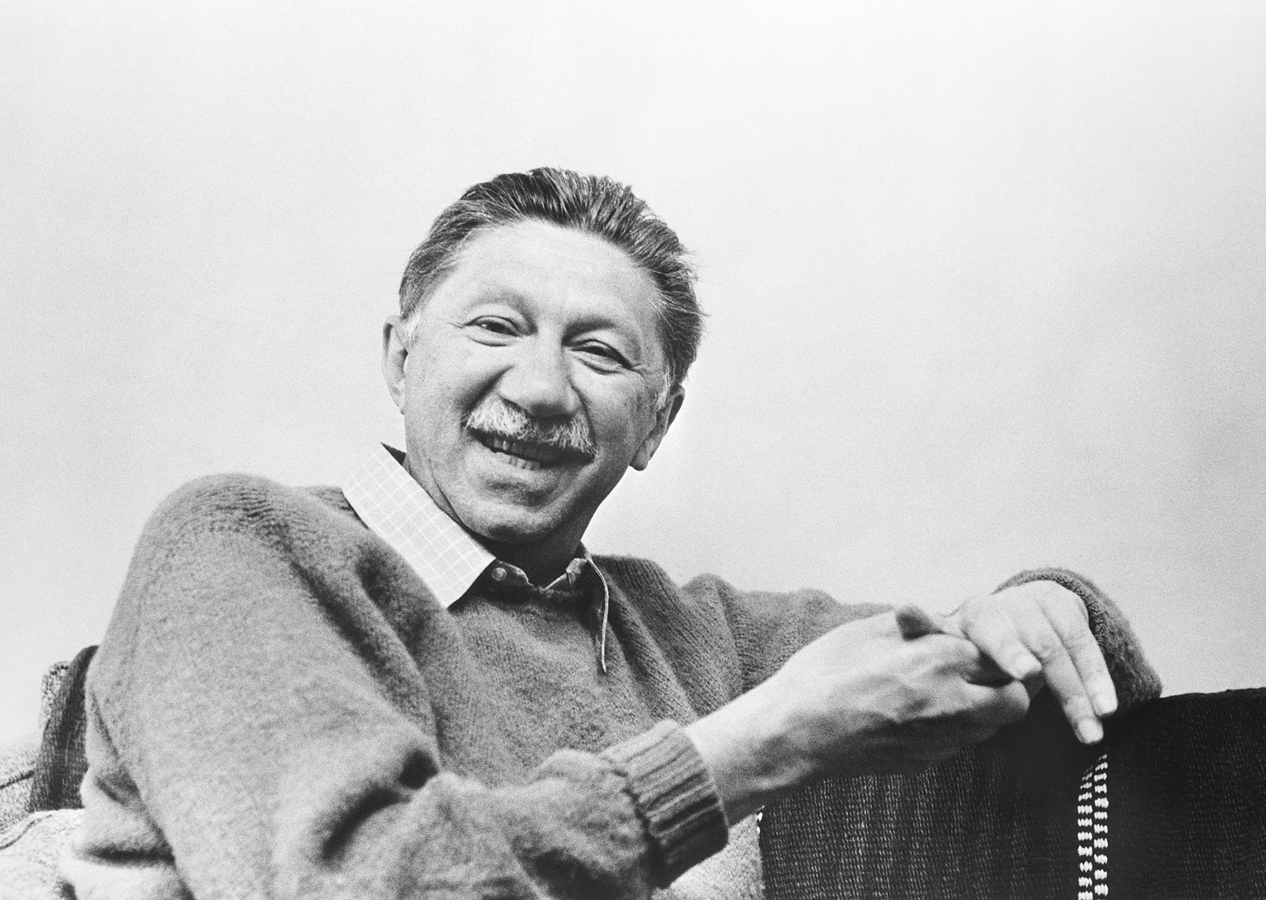
Maslow believed that all people—
- Physiological: needing food, water, warmth, and air
- Safety: feeling protected from injury and death
- Love and belonging: having friends, family, and a community (often religious)
- Esteem: being respected by the wider community as well as by oneself
- Self-
actualization: becoming truly oneself, fulfilling one’s unique potential while appreciating all of humanity
Especially for Nurses Maslow’s hierarchy is often taught in health sciences because it alerts medical staff to the needs of patients. What specific hospital procedures might help?
Response for Nurses: Reassurance from nurses (explaining procedures, including specifics and reasons) helps with the first two of Maslow’s needs; and visitors, cards, and calls might help with the next two. Obviously, specifics depend on the patient, but everyone needs respect as well as physical care.
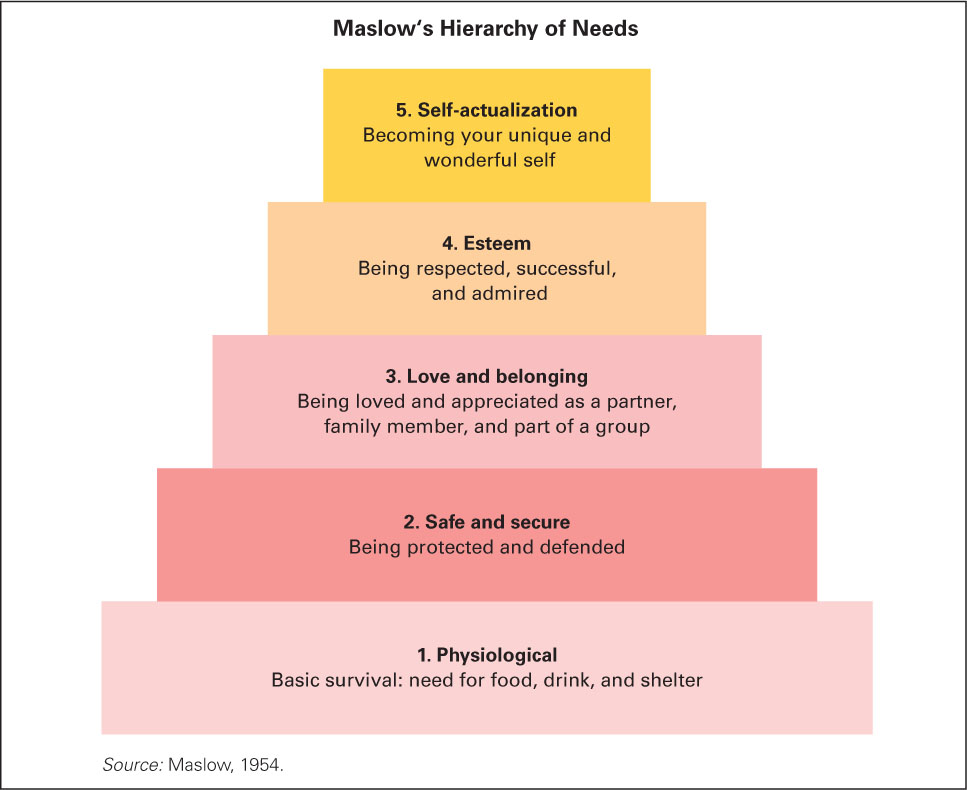
FIGURE 2.3
Moving Up, Not Looking Back Maslow’s hierarchy is like a ladder: Once a person stands firmly on a higher rung, the lower rungs are no longer needed. Thus, someone who has arrived at step 4 might devalue safety (step 2) and be willing to risk personal safety to gain respect.This pyramid caught on almost immediately; it was one of the most “contagious ideas of behavioral science” since it seemed insightful about human psychology (Kendrick et al., 2010, p. 292). At the highest level, when basic needs have been met, people can be fully themselves—
One sign of self-
Rogers also stressed the need to accept and respect one’s own personhood as well as that of everyone else. He thought that people should give each other unconditional positive regard, which means that they should see (regard) each other with appreciation (positive) without conditions (unconditional).
If parents do not have unconditional positive regard for their children, the danger is that the children will have long-
As you can see, humanists emphasize what all people have in common, not their national, ethnic, or cultural differences. Maslow contended that everyone must satisfy each lower level of the hierarchy of needs before moving higher. A starving man, for instance, may not be concerned for his own safety when he seeks food (level 1 precedes level 2), or an unloved woman might not care about self-
Although humanism does not postulate developmental stages, ideally as people mature they move up the hierarchy. Babies seek food and comfort, and not until adulthood can a person focus wholeheartedly on success and esteem, beyond the immediate approval of friends and family.
Satisfaction of childhood needs is crucial for later self-
Rogers agreed that adults who were deprived of unconditional positive regard in childhood might become selfish and antisocial. He developed a widely used method of psychological therapy to help people become more accepting of themselves and therefore of other people.
This theory is still prominent among medical professionals because they now realize that pain is not always physical (the first two levels), it can be social (the next two) (Majercsik, 2005; Zalenski & Raspa, 2006). Even the very sick need love and belonging (family should be with them) and esteem (the dying need respect).
Echoes of humanism are also evident in education and sports: The basic idea here is that people are more effectively motivated when they try to master a body of knowledge or a skill to achieve a “personal best”—that is, to reach the peak of their own potential—
Evolutionary Theory
You are familiar with Darwin and his ideas, first published 150 years ago: Essentially he showed that plants, insects, birds, and animals developed over billions of years, as life evolved from primitive cells to humans (Darwin, 1859). But you may not realize that serious research on human development inspired by this theory does not focus primarily on lower creatures, but instead studies the history of human characteristics. Evolutionary psychology is quite recent. As two leaders in this field write:
During the last two decades, the study of the evolutionary foundations of human nature has grown at an exponential rate. In fact, it is now a booming interdisciplinary scientific enterprise, one that sits at the cutting edge of the social and behavioral sciences.
[Gangestad & Simpson, 2007, p. 2]
Evolutionary theory has intriguing explanations for many issues in human development, including women’s nausea in pregnancy, 1-
To understand human development, this theory contends that humans should acknowledge the lives of our early ancestors. For example, many people are terrified of snakes, screaming and breaking into a cold sweat upon seeing one. However, virtually no one is terrified of automobiles. Yet snakes cause less than 1 death in a million, while cars cause more than a hundred times that. The extreme reaction to snakes derives from instinctive fears that evolved over millennia, when snakes were common killers. Thus,
Evolutionarily ancient dangers such as snakes, spiders, heights, and strangers appear on lists of common phobias far more often than do evolutionarily modern dangers such as cars and guns, even though cars and guns are more dangerous to survival in the modern environment (Confer et al., 2010, p. 111).
Especially for Teachers and Counselors of Teenagers Teen pregnancy is destructive of adolescent education, family life, and sometimes even health. According to evolutionary theory, what can be done about this problem?
Response for Teachers and Counselors of Teenagers: Evolutionary theory stresses the need for reproduction, which gives teenagers a powerful sex drive. Thus, informing teenagers of the difficulty of newborn care is unlikely to stop the sex drive. Better methods would make pregnancy impossible—
Since our fears have not caught up to modern inventions, we use our minds to protect ourselves with laws regarding seat belts, red lights, and speed limits. Humanity is succeeding in such measures: The U.S. motor-
According to evolutionary theory, every species has two long-
selective adaptation The process by which living creatures (including people) adjust to their environment. Genes that enhance survival and reproductive ability are selected, over the generations, to become more prevalent.
A basic idea from evolutionary theory—
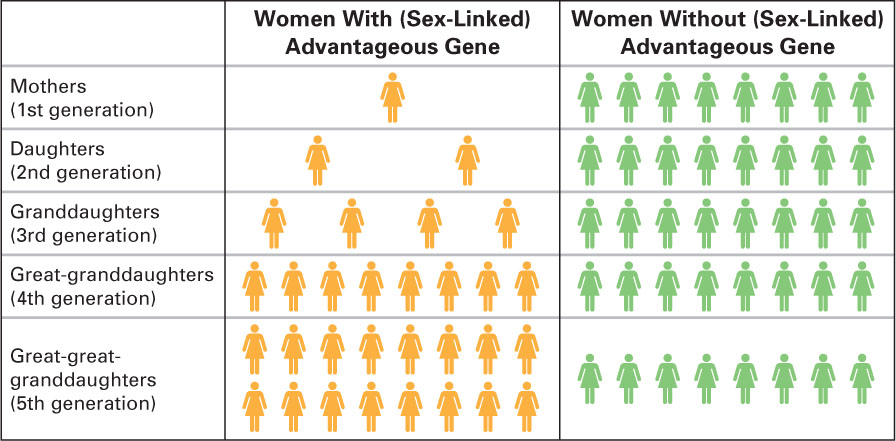
FIGURE 2.4
Selective Adaptation Illustrated Suppose only one of nine mothers happened to have a gene that improved survival. The average woman had only one surviving daughter but this gene mutation might meant more births and more surviving children, such that each woman who had the gene bore two girls who survived to womanhood instead of one. As you see, in 100 years, the “odd” gene becomes more common, making it a new normal.The process of selective adaptation works as follows: If one person happens to have a gene that makes survival more likely, that gene is likely to be passed on to the next generation because that person survives long enough to reproduce. Such a beneficial gene might have arisen as a mutation, or it might simply be a genetic combination that results in one end of the natural variation in height, body type, anxiety, or any other characteristic. Anyone who inherits such genes has an increased chance of growing up, finding a mate, and bearing children—

For example, originally all humans probably got sick after drinking cow’s milk; that is, they were lactose intolerant (Suchy, 2010). Then in a few regions thousands of years ago, cattle were domesticated and raised for their meat. In those places, “killing the fatted calf” provided a rare feast for the entire community when a major celebration occurred.
Although more than half of all babies died of malnutrition in ancient times, in cattle-
This process of selective adaptation continues over many generations. An odd gene allowing digestion of cow’s milk became widespread where plant proteins were scarce and cow’s milk meant survival. This might explain why few Scandinavians are lactose-
For groups as well as individuals, the interaction of genes and environment affects survival and reproduction, the two basic drives recognized by evolutionary theory. Genetic variations are particularly beneficial when the environment changes, which is one reason the genetic diversity of humans throughout the world benefits humanity as a whole. If a species’ gene pool does not include variants that allow survival in difficult circumstances (such as exposure to a new disease or to an environmental toxin), the entire species becomes extinct. This explains why biologists worry when a particular species becomes inbred—
Genetic variation among humans, differential sensitivity, and plasticity (explained in Chapter 1) enable humans to survive and multiply. This statement is true not only for biological traits (such as digestion of milk) but also for psychological traits that originate in the brain (Confer et al., 2010; Tomasello, 2009).
Evolutionary theory contends that certain epigenetic factors foster socialization, parenthood, communication, and language, all of which helped humans a hundred thousand years ago and allowed societies a few thousand years ago to develop writing, then books, and then universities. As a result, humans learn from history and from strangers in distant continents. The fact that you are reading this book, accepting some ideas and rejecting others, is part of the human heritage that will aid future generations, according to evolutionary theory.
In recent years, “evolutionary psychology has grown from being viewed as a fringe theoretical perspective to occupying a central place within psychological science” (Confer et al., 2010). This theory is insightful and intriguing, but some interpretations are hotly disputed.
For instance, an evolutionary account of mental disorders suggests that some symptoms (such as an overactive imagination or a crushing anxiety) are normal extremes of adaptive traits. This implies that few people should be considered mentally ill, an implication rejected by many psychologists. Also controversial are explanations of sex differences, as the following explains.
A VIEW FROM SCIENCE
If Your Mate Were Unfaithful
Men seek more sexual partners than women do. Brides are younger, on average, than grooms. These are norms, not followed in every case, but apparent in every culture. Why?
An evolutionary explanation begins with biology. Since females, not males, become pregnant and breast-
The evolutionary reasons that men acquiesced, sometimes becoming faithful partners to one woman despite their inclinations, included that men needed to keep rivals away in order to protect their children (Lukas & Clutton-
A historic conflict occurred because men were more able to father many children if they removed their rivals and had multiple sexual partners—
Does this interpretation have empirical, research support? Evolutionary scientists have asked people of many ages, nationalities, and religions to imagine their romantic partner either “forming a deep emotional attachment” or “enjoying passionate sexual intercourse” with someone else. After imagining that, people are asked which of those two possibilities is more distressing. The men generally are more upset at sexual infidelity while the women are more upset with emotional infidelity (Buss et al., 2004).
For example, one study involved 212 college students, all U.S. citizens, whose parents were born in Mexico (Cramer et al., 2009). As with other populations, more women (60 percent) were distressed at the emotional infidelity and more men (66 percent) at the sexual infidelity.
Evolutionary theory explains this oft-
Indeed, worldwide, men are more likely to go into a jealous rage if they suspect infidelity, sometimes beating their partner to death, which wives never do (Mize et al., 2009). The evolutionary explanation is not universally accepted, yet some sex differences, including this one, call out for theory and research.
Many women reject the evolutionary explanation for sex differences. They contend that hypothetical scenarios do not reflect actual experience, and that patriarchy and sexism, not genes, produce mating attitudes and patterns (Vandernassen, 2005; Varga et al., 2011).
Similar controversies arise with other applications of evolutionary theory. People do not always act as evolutionary theory predicts: Parents sometimes abandon newborns, adults sometimes handle snakes, and so on. In the survey of Mexican American college students that was cited in A View from Science, more than one-
Nonetheless, evolutionary theorists contend that humans need to understand the universal, biological impulses within our species, in order to control destructive reactions (e.g., we need to make “crimes of passion” illegal) and to promote constructive ones (to protect against newer dangers, by manufacturing safer cars and guns).
SUMMING UP
Newer theories of development are more multicultural, expansive, and multidisciplinary than the earlier, grand theories. Sociocultural theory emphasizes the varied cultural contexts of development. Learning occurs within the zone of proximal development, as the result of sensitive collaboration between a teacher (who could be a parent or a peer) and a learner who is ready for the next step.
Universal theories include humanism and evolutionary theory, both of which stress that all people have the same underlying needs. Humanism holds that everyone merits respect and positive regard in order to become self-